Kia ora! Is that summer we can see on the horizon? The city is definitely starting to feel festive.
The week in Greater Auckland
On Monday, Matt argued that it makes more sense to upgrade Swanson than Henderson in preparation for the post-CRL network.
Tuesday’s post looked at the proposed designs for three new rail stations at Drury.
On Wednesday, we shared a guest post by George Weeks all about the real cost of ‘free’ parking.
Yesterday, we had a day off 🙂
Downtown streets alive with people
Kirihimete has come to Te Komititanga, and Heart of the City is putting on events all weekend every weekend until Christmas. Head down to Te Komititanga and Commercial Bay for live music and roaming street performers every Friday, Saturday and Sunday, with the pop-up pavilion serving as main stage.
Keep an eye out also for festive-themed roving performers moving around the square including Christmas drag queens, stilt walkers, jugglers, Christmas elves and tinsel covered friendly monsters, there is sure to be something to surprise and delight all ages.
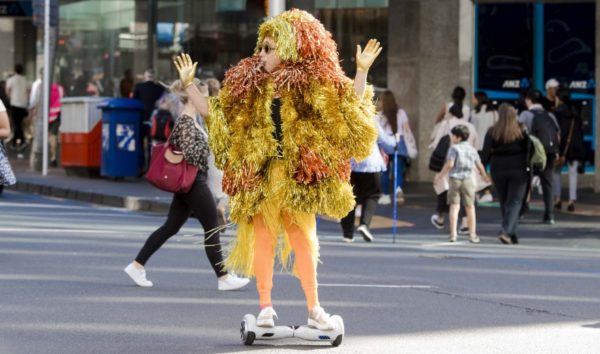
Meanwhile, Te Wai Horotiu Path is ready for its close up! The path was officially opened yesterday, and you might have seen the posters out and about advertising the path and guiding users on how to walk, ride and scoot along it (which… we’ve published our thoughts on this shared space already). However, as Alec Tang’s handy then/now comparison illustrates, the real gift of the Wai Horotiu path is more space on Queen Street for people.
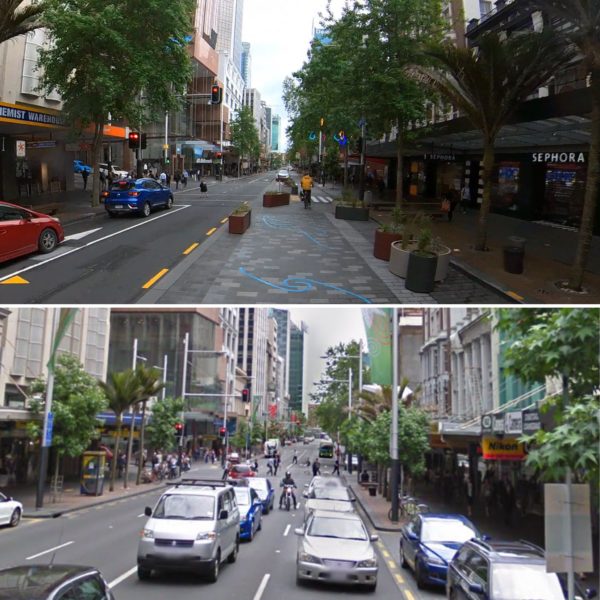
Speaking of space for people, Waka Kotahi’s Kathryn King was in Sydney this week, tweeting photos of one of our favourite antipodean city streets.
Am in Sydney for the Micromobility Conference and made the pilgrimage to George St. How glorious to have the space opened up for people and why can't we have this for Queen St asap please? pic.twitter.com/NTnmq0QHjI
— Kathryn King (@KingCyclesAkl) November 22, 2022
Getting around further afield
Still in Tāmaki, but a decent bus trip from Queen Street, mega-mega store Costco has been causing mild havoc at Westgate since it landed. The Spinoff’s Chris Schulz laments the chaos that the once-sleepy NorthWest Mall has become since people started driving from all over the city (and beyond, presumably) to shop in bulk from Costco’s erratic selection of goods. We enjoyed Schulz’ possibly unintentional description of how shared paths fail;
The very worst part, the nadir of this fiasco, is the “shared space” between the mall and Te Manawa library. It’s envisioned as a utopian paradise where adults, kids, motorbikes, cyclists, courier vans, trucks and cars frolic together while peacefully enjoying the trees, grass and concrete zones. When no one was there, the ‘sharing’ went fine. Now, especially on weekends, it operates as a confusing logjam of frustrated drivers and pedestrians trying to work out who has right of way.
A low-traffic-school in Hawera! Te Paepae o Aotea, Hawera’s new combined intermediate and high school has temporarily expanded across the road, and the school’s principle has succeeded in getting the street closed during school hours. Camberwell Road, which separates new classrooms for year 11-13s from the rest of the school, will be closed from 8:30am to 4pm so that it’s safe for students to get across.
The week in … rain-induced potholes: The Herald’s Georgina Campbell reports on more issues with Transmission Gully’s seal. Sections of the road had to be closed to fix 14 potholes that appeared after a dump of unusually heavy rain in the weekend.
“Plans are already in place for five nights of work from Sunday this week to undertake pre-emptive repairs to six short sections of the Transmission Gully motorway where monitoring had identified pavement performance that wasn’t to standard.”
Potholes: a problem that’s only going to get worst in a fossil-fuel-induced warming climate.
Leading on climate change
Like transport, climate change and its various scenarios can be hard to comprehend and even harder to explain. We really liked this diagram by European Commission climate scientist Giacomo Grassi explaining our path so far, and the options we’ve got left.
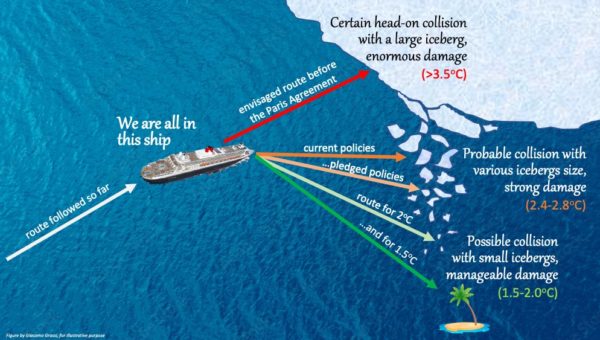
And our leaders can do a lot to both shift populations’ opinions and send a message that they’re taking our futures seriously. This PhD candidate found that when leaders adopt low-carbon behaviour, there are some pretty powerful flow-on effects.
When leaders adopt high-impact low-carbon behaviours, people search for the *meaning* of the behaviour… What does the leader’s action say about:
What the leader believes?
Their motives?
Climate change as a problem?
Society’s response?
Our own behaviour?
Follow the tweet below to read the whole thread.
https://twitter.com/steviedubyu/status/1593597771952492544?s=46&t=Z2r5DagTzqI1z7WQw2rG9w
Looks like Aotearoa’s Climate Commission is diving into some important transport concepts too. Traffic circulation plans are used to reduce both traffic and emissions in many cities around the world. Auckland’s A4E is our own home-grown example – it’s just not implemented yet.
In Ghent traffic dropped from 55% to 27%. They had a huge upsurge in cycling that allowed them to reach their cycling modeshare goal (35%) 13 years early. Leueven saw a a 32% increase in cycling in one year
It was great to chat with the Climate Change Commission about traffic circulation plans and what they can do to reduce transport emissions (and how they make city centres awesome). 1/
— Kent Lundberg (@kentslundberg) November 23, 2022
Reducing cars for the sake of public life
In a recent Weekly Roundup we shared a Guardian article about research into the most effective ways to reduce car travel in cities. This week, we came across a fantastic illustration of the top 12 solutions on climate activist Kimberly Nicholas’ blog- and it’s clearly doing the rounds, because it also pops up at the end of the thread we linked to above.
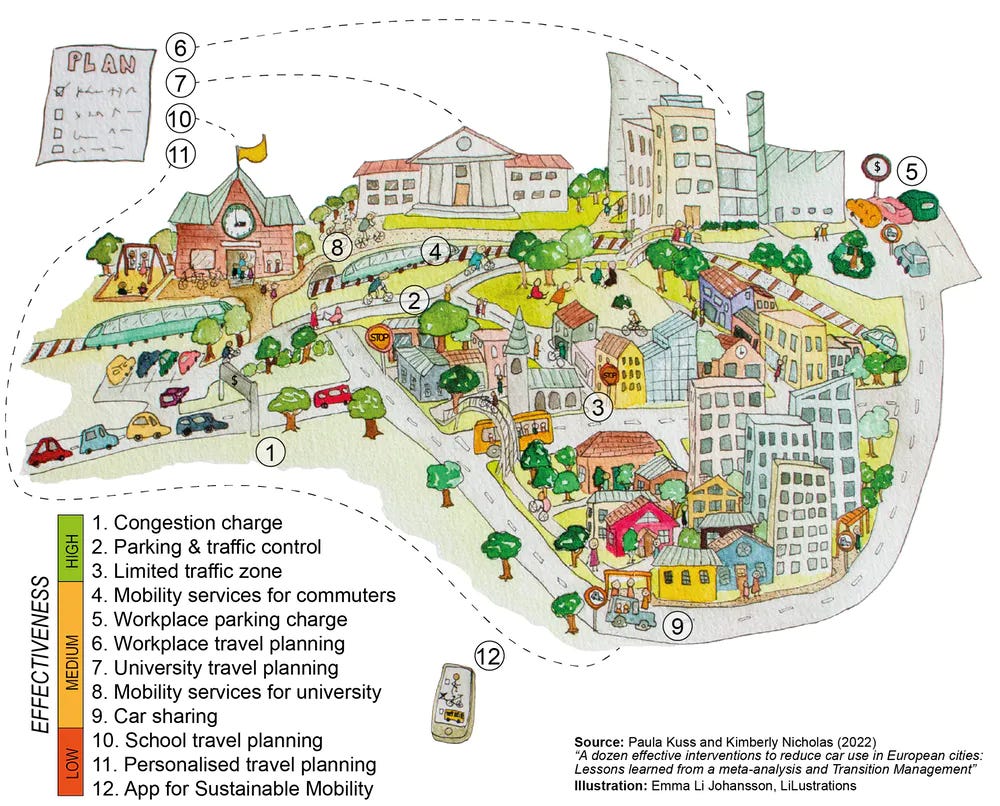
It’s always worth remembering the kinds of spaces we get when cars are taken out of them, like being able to step out of your door and be minutes from work, school, friends, and food –
If you have proximity, there is really no need for speed. pic.twitter.com/6mbQvLEyx4
— Queen Anne Greenways (@QAGreenways) April 29, 2022
Or the chance to completely, utterly lose it when your team pulls off an impossible victory!
I fucking love this pic.twitter.com/nF4vldB8bS
— Rory Flanagan (@Rory_Flanagan) November 22, 2022
Longer journeys, better by rail
Your weekend must-read is this astonishing piece on the New York Times about keeping the Ukrainian Railways running through the war (that’s a paywall-free link.)
Trains quickly became the backbone of the country: essential to the war effort, crucial to moving people, weapons, goods and supplies, as well as providing a diplomatic avenue and an economic lifeline. As Russia began to target critical infrastructure, the job took on an added danger. Trains “running on schedule” — a catchphrase Kamyshin repeated as a mantra — became a symbol of normalcy in the most abnormal situation.
Train rides we’re itching to take…
Japan definitely does cute trains better than anyone else. These pictures of a sightseeing train in Toyama could be straight from a Studio Ghibli landscape.
Writing on Stuff, Peter Calder rhapsodizes about a recent long-haul train trip around the USA with an Amtrak rail pass. For just NZ$800, you can take ten trips in 30 days on any Amtrak train, and Calder managed to clock 12,583km over 175 hours in a wonderful slow-travel experience of the vast expanse between US coasts. It sounds like the only downside was the terrible coffee.
America passes by in all its varied glories: the dazzling Glacier National Park in the Rockies; the endless cornfields of Minnesota; the smoke-belching Rust Belt factories; the bayous of the South and the deserts of the Southwest. Rail lines commonly pass backyards, too, giving the passing traveller a glimpse into private lives. A rail traveller can really claim to have “seen” the country.
If you’re an Elizabeth Line fan, check out this news item about how well its working now it’s open. The Elizabeth Line as had a huge impact on passengers, and one woman describes her journey going from more than an hour to just 30 minutes.
https://twitter.com/mayoroflondon/status/1594784305162903552?s=61&t=huBi40LkY0ulx2Us0yB_Xw
Vintage PT theory – they had it in the 60s too
Citizen Tram is a 1960s Melbourne Tramways promotional video in which an irate car driver gets schooled about the effectiveness of trams versus cars for moving people around.
A bit of transport leaking in
Once you see it, you can’t unsee it. Transport is everywhere!
For the literary GA readers: VUW Press editor and ebike resistor Ashleigh Young claims she’s re-branding her personal blog as a cycling blog.
Tuesday: Rode to work. Two close passes on Raroa. It’s so weird to me how some drivers seem to thrive on chaos, blasting past me on blind corners and desperately narrow roads, right into oncoming traffic.
Te Ara i Whiti was Anita’s perfect backdrop this week –
https://twitter.com/anitawiglit/status/1595214844348620801
SJD’s last video was comprised of footage from one ordinary street corner in Beijing, in his latest, two mates wander around suburban streets, catch the bus, and wait for the train. And it’s a great song.
Kua mutu mātou – that’s all from us, hope you’ve got a lovely weekend ahead.





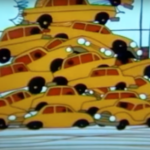

 Processing...
Processing...
You noted the example of the Elizabeth Line in London. If I may, this traveller’s tale:
I had occasion to use it recently when I had flown into Heathrow and my onwards flight was from London City Airport; which is 22 miles as the crow flies, and a lot longer by land (30 miles or so). I was able to catch an Elizabeth Line train all the way across to Woolwich in East London, from where it was a near-seamless transfer to the DLR and back to London City. This took an hour and ten minutes; otherwise, by Tube, I would have had to allow close to two hours (and two transfers, with luggage).
I don’t often describe transport investment as groundbreaking, but this was.
Amazing to think that other places recognise the important of university-related travel in reducing congestion and emissions, yet in Auckland we have a huge road running through one of our oldest, separated from one of our newest on the other side by yet another road.
Parklandify Symonds St?
Yes – that road is rubbish. But they need to integrate the universities into the city more. It’s the only part of the city dead on a weekend. They need to add some more commercial and residential around the campuses to actually make them appealing.
Also, here’s a thought exercise for a Friday: Say Light Rail is dead (Really hard to imagine, I know). The proposed alternative is to start building a fully underground rail network across Auckland, from the outside working its way in, eventually taking the existing Southern and Western Lines underground, but with a priority on extending the rail network and complimenting these lines before replacing them, in order to gain extra time saved on journeys and solve the level crossing issues across the region.
So, to the question: Where do you start your TBMs, where do you point them, and how would you link them up with the existing network? Or would you build a second rail loop, and where? Or would you use surface light rail to create a cross town bridge between your new web of underground rail lines?
“Light Rail underground serving new areas was too expensive for us, so now lets plan heavy rail underground serving the same areas”?
That’s the question – if Light Rail is off the cards, what do we do instead?
Carry on with the plan of making Auckland s**tter so eventually we get the population down to under a mill. Seems to be working so far 🙁
We stick with buses and wait 30 years until everyone associated with the light rail debacle has moved on. Exactly what we did after the 1990 light rail debacle. Then we hope the next people are not as daft as the previous one.
Yeah but confused by this one. ‘Yeah just popping down into the underground station in the metropolis of Fruitvale’
I’ll have a busway along the Northwestern first, thanks. And other areas planned for intensification.
I’m unsure how they can do that now, given that it’s built right up the edge of the corridor now in some places. I’m also genuinely concerned we’ll have to make insane compromises like AMETI did and end up with something that can never be upgraded to Light Rail.
I try not to think about it these days. I just get too mad.
Central running with lifts and stairs to the perpendicular bus interchanges on overbridges. Just be bold and take a lane both ways.
There would be people that genuinely think that bottom picture of Queen Street is better!
It does have more people in it.
Nelson Street also carries lots of people, vanishingly few of whom consider it a destination.
They have improved the amenity for homeless people, so that’s something.
In 1950 and today, for those with their thinking on hold in that decade.
What exactly is the point of the Queen st changes? Just made it worse for buses with only one lane so you get cars clogging up the street. Down by the luxury shops there’s some weird sort of loading bay normally just filled with expensive cars (ie not services vehicles).
Once again we seem to push on with these crappy shared spaces which are like the worst of both worlds for all users.
That’s what you get when you try to have a bob each way – towards improvement, and towards Status Quo.
Contrary to the claim of “if both sides are equally unhappy you are doing things right”, it actually only leads to situations like the current one, where agencies like AT are hated by both sides – the progressives because AT seems to be constantly undermining their own policies by regressive car-focussed decisions, and the status quo folks, because AT spends so much time talking (if not actually doing) about change.
Incremental change only works if it isn’t too compromised. I can’t talk of the Queen Street changes as I haven’t really experienced them yet much, but far too many projects over the last decade – if not cancelled outright – were a mess for everyone because key elements were compromised.
+1000 fully agree.
on point. I feel like AT don’t have anyone with vision. They just listen to people through endless consultations and trying to give bits to everyone. As a result no one is happy. They should just make a good plan, consult the experts and engineers and follow through no matter what people say.
+1, a this because AT got too scared to ban cars like they were told to.
“Or the chance to completely, utterly lose it when your team pulls off an impossible victory!”
This media has been disabled in response to a report by the copyright owner
Thursday just wasn’t the same without you.
Northwest Mall is beautiful, it completely exemplifies how much we love our car centricity. With all that mall parking, we still need those few other spaces right next to the shops so people walking and playing keep feeling inferior.
Now with costco we are getting people to experience what Queen street used to be.
Since it’s Friday I’ll put in a link to the youtube channel “Darryl Talks About New Zealand”. Darryl does regular videos including those with ideas for Rail and other projects in New Zealand.
He’s done some recent ones on Auckland Light Rail and Christchurch rail.
I don’t agree with all his ideas but AFAIK he’s the only one in NZ making these
https://www.youtube.com/@DarrylTalks
I fear the Queen Street space reallocation will only be temporary. Wayne Brown is unlikely to support it.
Brown is too tight-fisted to pay to reverse any of the work.
Auckland is too broke to afford it, $295M fiscal hole and counting. Just wait til the CRL over run arrives for Xmas. And they’ve borrowed up to the debt ceiling already. People can’t afford a 13% rates increase. https://ourauckland.aucklandcouncil.govt.nz/news/2022/11/budget-hole-blows-out-to-295-million/
13% isn’t that much above inflation.
Which people can’t afford a 13% rates increase, Anthony? Some can’t, sure. And others can, and should’ve been paying a lot more for decades. The big expenses are in roading. That’s what needs to be trimmed. Not the projects that make our city streets liveable.
Interesting stuff going on.
Random fact for the day:
By 2020, Toyota reclaimed its position as the largest automaker in the world, surpassing Volkswagen.[71] It sold 9.528 million vehicles globally despite an 11.3% drop in sales due to the COVID-19 pandemic.
Brown is too cheap to pay to undo any of the work.